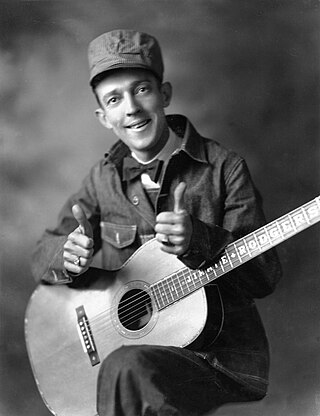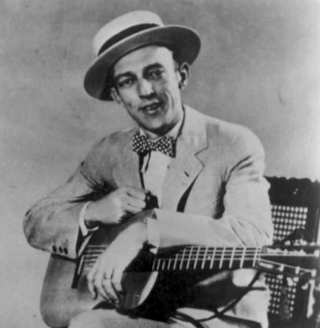
Clarence Eugene "Hank" Snow was a Canadian-American country music artist. Most popular in the 1950s, he had a career that spanned more than 50 years. He recorded 140 albums and charted more than 85 singles on the Billboard country charts from 1950 until 1980. His number-one hits include the self-penned songs "I'm Moving On", "The Golden Rocket", and "The Rhumba Boogie"; and famous versions of "I Don't Hurt Anymore", "Let Me Go, Lover!", "I've Been Everywhere", "Hello Love", as well as other top 10 hits.

Yodeling is a form of singing which involves repeated and rapid changes of pitch between the low-pitch chest register and the high-pitch head register or falsetto. The English word yodel is derived from the German word jodeln, meaning "to utter the syllable jo". This vocal technique is used in many cultures worldwide. Recent scientific research concerning yodeling and non-Western cultures has shown that music and speech evolved from a common prosodic precursor.

Lee Wiley was an American jazz singer during the 1930s, 1940s, and 1950s.

James Charles Rodgers was an American singer-songwriter and musician who rose to popularity in the late 1920s. Widely regarded as "the Father of Country Music", he is best known for his distinctive rhythmic yodeling, unusual for a music star of his era. Rodgers rose to prominence based upon his recordings, among country music's earliest, rather than concert performances.

James Frederick Rodgers was an American singer and actor. Rodgers had a run of hits and mainstream popularity in the 1950s and 1960s. His string of crossover singles ranked highly on the Billboard Pop Singles, Hot Country and Western Sides, and Hot Rhythm and Blues Sides charts; in the 1960s, Rodgers had more modest successes with adult contemporary music.

"(You're the Flower of My Heart,) Sweet Adeline" is a ballad best known as a barbershop standard. It was first published in 1903, with lyrics by Richard Husch Gerard to music by Harry Armstrong, from a tune he had written in 1896 at the age of 18. According to a 1928 newspaper story, the lyrics were inspired "by a girl who worked at the music counter of a New York department store." After failing to find a publisher with the initial title, "You're the Flower of My Heart, Sweet Rosalie", according to a story the two decided a new title was in order and were inspired by a poster advertising the farewell tour of opera singer Adelina Patti. It did not become a hit until it was performed in 1904 by the group The Haydn Quartet. The Haydn Quartet's version was #1 for 10 weeks in 1904, and the Peerless Quartet also hit #1 with their version in 1904, for three weeks, according to Joel Whitburn's Pop Memories.

"Blue Yodel no. 8, Mule Skinner Blues" is a classic country song written by Jimmie Rodgers. The song was first recorded by Rodgers in 1930 and has been recorded by many artists since then, acquiring the de facto title "Mule Skinner Blues" after Rodgers named it "Blue Yodel #8".
"Blue Yodel #9" is a blues-country song by Jimmie Rodgers and is the ninth of his "Blue Yodels". Rodgers recorded the song on July 16, 1930 in Los Angeles with an unbilled Louis Armstrong on trumpet and his wife Lil Hardin Armstrong on piano. Armstrong and Hardin were not listed on this session due to Armstrong's contract with Okeh; this session was for Victor. According to Thomas Brothers, the irregular blues form along with the irregular phrases used by Rodgers frequently threw off Armstrong until he reached his own solo chorus, where he sticks to a regular 12 bar blues form.
"In the Jailhouse Now" is an American novelty blues song originally found in vaudeville performances from the early 20th century, usually credited to Jimmie Rodgers. The song's first two verses trace the exploits of Ramblin’ Bob, who cheats at cards and gets caught, while the final verse tells about taking a girl named Susie out on the town and winding up in jail together.
This is a list of notable events in country music that took place in the year 1933.
This is a list of notable events in country music that took place in the year 1931.
This is a list of notable events in country music that took place in the year 1929.
This is a list of notable events in country music that took place in the year 1928.
The blue yodel songs are a series of thirteen songs written and recorded by Jimmie Rodgers during the period from 1927 to his death in May 1933. The songs were based on the 12-bar blues format and featured Rodgers’ trademark yodel refrains. The lyrics often had a risqué quality with "a macho, slightly dangerous undertone." The original 78 issue of "Blue Yodel No. 1 " sold more than a half million copies, a phenomenal number at the time. The term "blue yodel" is also sometimes used to differentiate the earlier Austrian yodeling from the American form of yodeling introduced by Rodgers.

"Blue Yodel No. 1 " is a song by American singer-songwriter Jimmie Rodgers. The recording was produced by Ralph Peer, who had originally recorded with Rodgers during the Bristol Sessions. It was released by the Victor Talking Machine Company on February 3, 1928. Rodgers recorded it during his second session with Victor, on November 30, 1927.

Ramblin' Jack Elliott Sings Songs by Woody Guthrie and Jimmie Rodgers is an album by American folk musician Ramblin' Jack Elliott. It was released in 1960 in Great Britain and in 1962 in the US on the Monitor label.
Elsie McWilliams was a songwriter who wrote for Jimmie Rodgers. McWilliams, even though she is only officially credited with writing twenty songs, actually wrote or co-wrote 39 songs for Rodgers. McWilliams was his most frequent collaborator. She was the first woman to make a career as a country music songwriter.
"Chemirocha" is a series of three field recordings by ethnomusicologist Hugh Tracey during his visit to the Kipsigis people of the Great Rift Valley of Kenya. The tribe had previously heard the recordings of American singer Jimmie Rodgers, which they integrated to their musical culture.

"Waiting for a Train" is a song written and recorded by Jimmie Rodgers and released by the Victor Talking Machine Company as the flipside of "Blue Yodel No. 4" in February 1929. The song originated in the nineteenth century in England. It later appeared in several song books, with variations on the lyrics throughout the years.

The discography of Jimmie Rodgers is composed of 111 songs that spanned the blues, jazz and country music genres. His first recording was made on August 4, 1927, during the Bristol sessions. The sessions were organized by Ralph Peer, who became Rodgers' main producer. Rodgers enjoyed success. At the height of his career, he made US$75,000 in royalties in 1929. After the Great Depression, his sales dropped to US$60,000. His last recording session took place in New York City on May 24, 1933. Rodgers died the same night at the Taft Hotel after years of suffering from tuberculosis.












